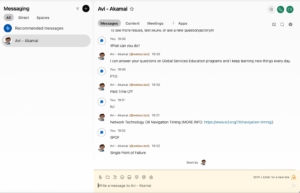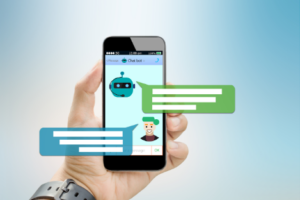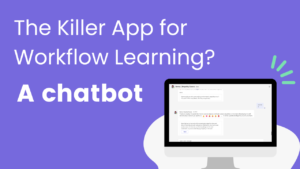Guest Post by Margie Meacham
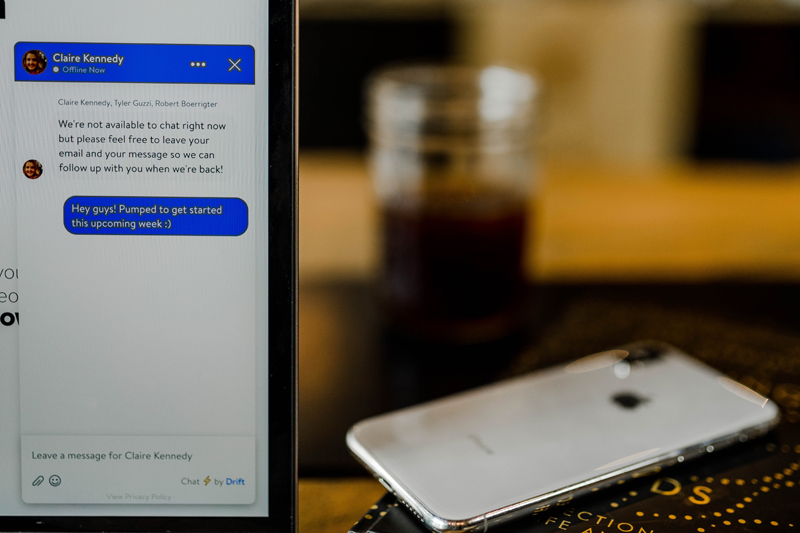
If you’ve been thinking about adding a chatbot to your learning program this year, this article is for you.
Chatbots have become widely used and relied on in many industries. According to one survey, it is the preferred experience for online users of any age or demographic group. You may have interacted with a chatbot customer service agent, for example, or received appointment confirmation texts from your doctor’s office. These examples not only make life easier for the user – they change behavior. And behavior change means that learning is taking place.
If the talent development profession follows the trends exhibited in other businesses, we should expect chatbots in corporate training and education to be fairly common by now. So, where are they?
In my opinion, our profession is lagging behind in part because it is hard to visualize how to use chatbots in training and education. Here are a few ideas:
Deliver performance support at the time of need
Whether a worker is on a manufacturing floor, or a salesperson is meeting with a customer, the modern workplace often allows little time to fire up a laptop and search for a solution to a problem. One of my clients is embedding intelligent chatbots into online reference documents and order processing tools. The coaching bot appears to offer suggestions and help whenever the user appears to be “stuck,” or making a less than optimal choice.
Challenge the learner to reflect
In today’s fast-paced digital environment, there is often little, if any, time allowed for reflection. Yet, as educator John Dewey said, “we learn from reflecting on experience.” The conversational nature of the chatbot can reflection back to learning, by asking questions that require a deeper response than simply choosing a multiple-choice option.
One interesting example comes from an online spiritual counselor I work with. Her mission is to help people navigate difficult choices at the most difficult times of their lives. When she is not available to meet with her clients, she offers an online chatbot. The bot asks leading questions to help the client determine possible steps to take.
Provide 24/7 performance coaching
Today’s learners need support anytime, anywhere. Access to a chatbot can provide much-needed coaching and support, providing sales professionals realistic practice in handling customer objections. The more the bot is used, the more nuanced the responses from the “customer” become.
Assess knowledge and retention
According to the U.S. Department of Education, assessments should be learning experiences. However, the typical standardized test is at best a poor instrument for achieving this end. Because a chatbot can be programmed to deliver questions in an order that responds to the previous answers of the learner, we can use chatbot technology to simulate the “Socratic method” approach to asking questions, turning an assessment from a “gotcha” moment to one of insight and discovery.
Direct user attention where it needs to be
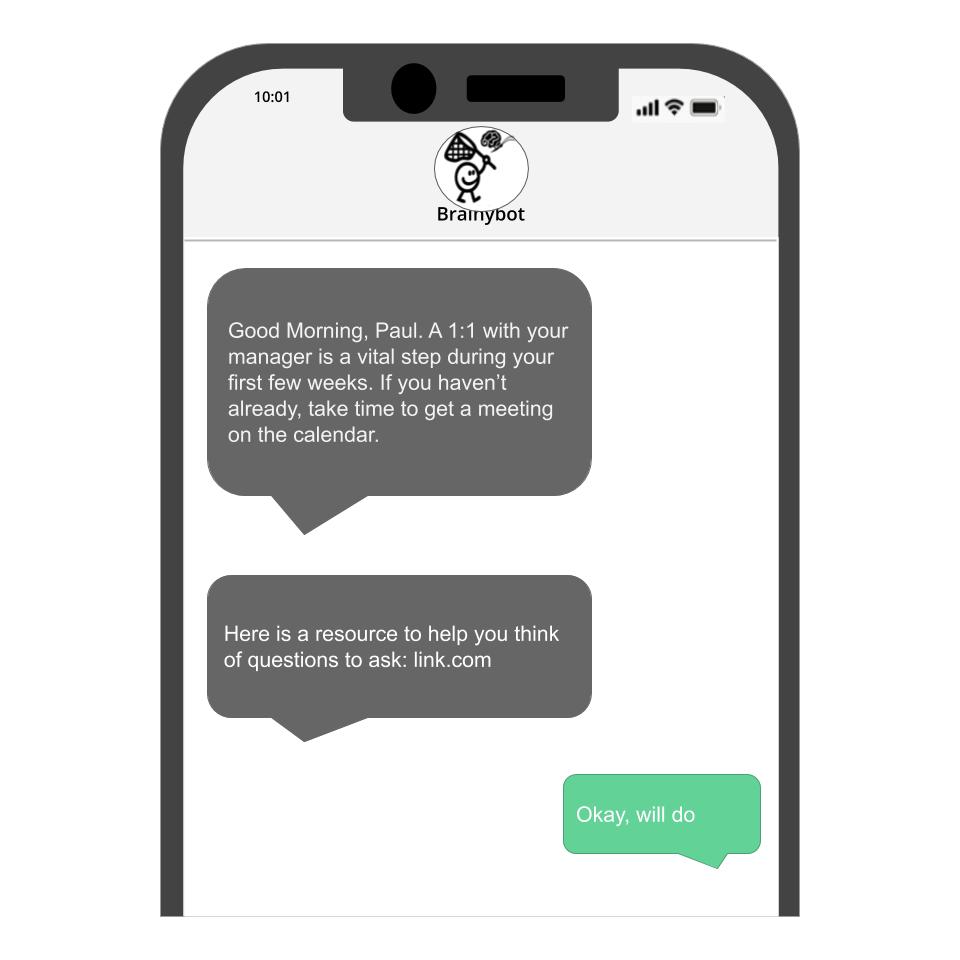 The harsh reality of digital media is that most people don’t read it. They scroll and skim, often not even doing that all the way to the end of the page or online document. If you have important content posted online, a chatbot can help direct learner attention where it needs to be, by sharing links and asking pointed questions. For example, a single “Hi there. Did you notice the announcement at the top of the page?” can go a lot farther than sending out a message from management that begins with “Please read.”
The harsh reality of digital media is that most people don’t read it. They scroll and skim, often not even doing that all the way to the end of the page or online document. If you have important content posted online, a chatbot can help direct learner attention where it needs to be, by sharing links and asking pointed questions. For example, a single “Hi there. Did you notice the announcement at the top of the page?” can go a lot farther than sending out a message from management that begins with “Please read.”
Make sense of complex or extensive content
According to Forbes magazine, there are 2.5 quintillion bytes of data created each day at our current pace. As available digital information continues to explode, content curation becomes more and more important to the learning profession. An intelligent bot can use the keywords entered by the user to search for relevant, credible information and deliver suggestions. A well-designed chatbot feels like a friendly advisor. The conversational tone of the interface makes it far more likely that the user will accept and act on the recommendation.
Analyze Learning Behavior
Perhaps the most valuable use of chatbots happens behind the scenes. While the user is interacting with the bot, the program is collecting all sorts of data on the user’s behavior. For instance, how often and how long an individual engages with the bot, what links they click or don’t click, and what questions they ask. This steady stream of data can be used to improve the learner experience, identify new topics or questions, and recognize trends in user preferences and desires. Even the simplest chatbot application has the ability to provide powerful insights from the user data collected on your intranet, webpage, or LMS.
Build it or buy it?
A classic question when acquiring any new technology, should you build it using in-house resources, or pay an outside firm to build it for you. You can outsource the build, but you should never outsource the design. Staying engaged throughout the entire process is the only way to ensure that you achieve the results you need. Start by asking a few fundamental questions.
- What problem are you trying to solve?
- What are the most likely causes of this problem?
- How can a chatbot address one or more of these causes?
- What information does the bot need in order to help the user?
- What should happen if the user needs something outside of the bot’s capabilities?
A Third Option: Bot in a Box
Working with my clients I experienced, the hardest part of implementing anything new is often getting started. In order to gain stakeholder support, user participation, and funding, it is often necessary to build an initial “proof of concept” prototype. This initial version must:
- Address a specific and important problem
- Be inexpensive to build, implement and manage
- Allow for minor “tweaking” to fit your needs
I’ve also discovered that the most compelling use cases for talent development chatbots fall into one of these use cases:
- New Employee Onboarding
- New Manager Development
- Training Reinforcement
Since I couldn’t find anything like that, I started asking some of the major suppliers of custom chatbots to work with me to produce a “semi-custom” approach. I found the perfect partner in Mobile Coach, a leading provider of enterprise-grade platforms for custom chatbots. We call our collaboration a “bot in a box” and the product fills a specific need to give smaller organizations a chatbot they can use almost immediately for around $1,000. For many, one or more of these Learningtogo Mobile Coach bots may be all you need to deliver a significant benefit to your organization. When your needs become more sophisticated, you’ll have gained the experience to make an informed decision about upgrading your program.
Helpful Tips
We’ve covered a lot of ground in this post, but you won’t really be able to apply it until you roll up your sleeves and get to work. Here are a few tips to keep in mind:
- Just do one thing with your chatbot. Solve one problem and demonstrate that you’ve solved it.
- Build a “minimally viable product” first. You can always embellish the look and feel of the bot after you’re sure that it works.
- Make it personal. The power of the chatbot lies in its ability to trick the user’s brain into having an authentic experience.
- Test-implement-test. It’s like “wash-rinse-repeat,” only for bots instead of hair. It’s my number one recommendation for achieving your best results.
- Get a “bot in a box” to get started quickly while avoiding “beginner mistakes.”
Is a chatbot in your future? If you continue to work in talent development, instructional design, eLearning development, teaching, corporate training, or just about any other profession, the answer is “yes.”
About Margie
 Margie is the Chief Freedom Officer of Learningtogo and a recognized leader in the application of neuroscience and artificial intelligence to enhance learning and performance. She is a recipient of the 100 Most Innovative in Learning award and a frequent keynote speaker at industry conferences. She teaches the ATD online course, Essentials of Brain-Based Learning and is a founding member of The Brain Ladies, a consortium of leading experts in applied cognitive science. You can connect with her on LinkedIn and Twitter.
Margie is the Chief Freedom Officer of Learningtogo and a recognized leader in the application of neuroscience and artificial intelligence to enhance learning and performance. She is a recipient of the 100 Most Innovative in Learning award and a frequent keynote speaker at industry conferences. She teaches the ATD online course, Essentials of Brain-Based Learning and is a founding member of The Brain Ladies, a consortium of leading experts in applied cognitive science. You can connect with her on LinkedIn and Twitter.
Get a Demo
Learn how Mobile Coach chatbots will help you drive real engagement with your audience to achieve the key behaviors and results you want.
